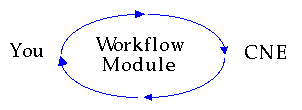 Using Workflow Loops in the Domain of Software Architecture
Using Workflow Loops in the Domain of Software Architecture
A growing number of software designers are adopting the view that a clear understanding of the commitments people are making in the domain in which the software will be used is essential for a reliable and effective design (Denning and Dargan 1994). This implies that coordination-based workflow may be of use to software designers. The traditionally hard problems in software design could be more amenable to solution if software systems were seen as tools of coordination rather than as specification-meeting objects.
 CSCW and Workflow
CSCW and Workflow
Computer Supported Cooperative Work (CSCW) is closely connected with workflow and organizational processes; some say that the language-action interpretation originated in CSCW research. CSCW is concerned with tools, technologies, and protocols for automated support of group work practices. Many of these tools will be essential for enterprises in large networks. Most of the existing tools, however, are concerned with sharing of certain kinds of objects such as workspaces or decision-support systems, and not with the actual work processes in which these objects are useful. Workflow models and maps can help make the context for other CSCW tools explicit.
 Process Modeling
Process Modeling
Queueing network technologies have been available since the mid 1970s as powerful, computationally efficient tools for calculating throughput and response time in computer systems (MenascÚ et al 1994). Many papers and books have been written in this area. The methods and algorithms are well known. Thus it appears feasible to construct analytic models for workflow maps and to use existing solvers to evaluate those models and calculate performance predictions of the original organizational process. A future research direction is to incorporate these existing algorithms into the models that evaluate workflow maps. There are currently no tools for modeling and anticipation, and this will shortly be an area of great need to advance workflow technology to its next stage of development.
 Connecting Information Processes to Workflow Maps
Connecting Information Processes to Workflow Maps
The history of technologies for supporting materiel and information processes shows three stages of performance models: mapping, measurement, and anticipation. Technologies for business process re-engineering have just entered the mapping stage. For example, ATI's tool for drawing business process maps is now being deployed and case studies are starting to accumulate. The ActionWorkflow Management System represents business process maps in a database, where it also records the times of state-changes from event-notices sent by applications that implement state-changes in workflows. However, creating tools for connecting client-server information processes to business processes within these maps is an open research area.

